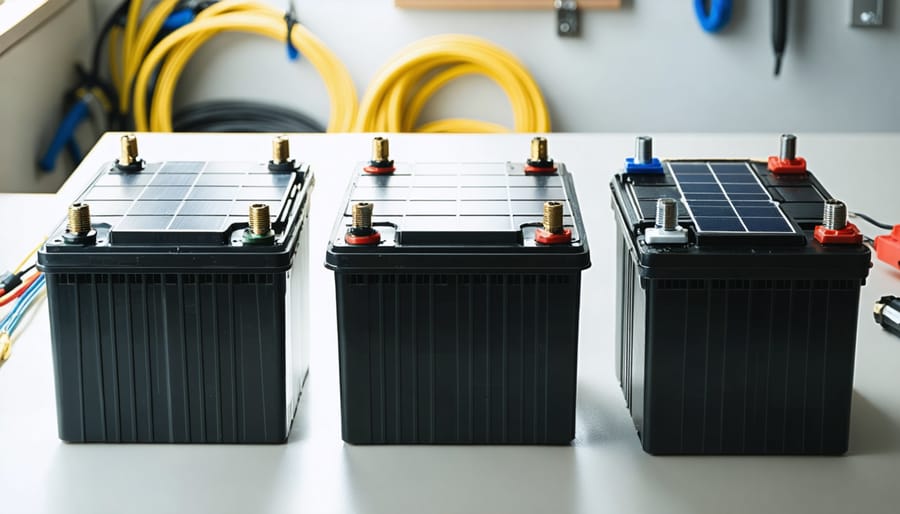Lifepo4 Voltage Chart: Understanding Battery Capacity, Performance and Charging
Updated:

A LiFePO4 battery voltage chart displays how the voltage is related to the battery’s state of charge. These charts vary depending on the size of the battery—whether it’s 3.2V, 12V, 24V, or 48V.
This article will dive deep into interpreting these charts and their practical implications. We’ll also cover the features and workings of LiFePO4 batteries, how voltage and capacity are related, and the factors that affect voltage measurements.
By the end of this article, you’ll have a comprehensive understanding of how to read and use LiFePO4 battery voltage charts to maximize your battery’s performance and lifespan.
Voltage Charts for 3.2V, 12V, 24V and 48V LiFePO4 Batteries
A LiFePO4 voltage chart represents the battery’s state of charge (usually in percentage) based on different voltage levels.
The state of charge (SOC) of a LiFePO4 battery indicates how much usable capacity is left. SOC is determined by measuring the battery’s open circuit voltage (OCV), which is its resting voltage with no load or charging applied.
As the battery discharges, its OCV declines. So we can estimate SOC based on voltage. However, the voltage curve from full to empty is flat, making SOC estimation less accurate.
Here are the typical voltage vs. SOC relationships for LiFePO4 batteries of different voltages:
3.2V LiFePO4 Cell Voltage Chart
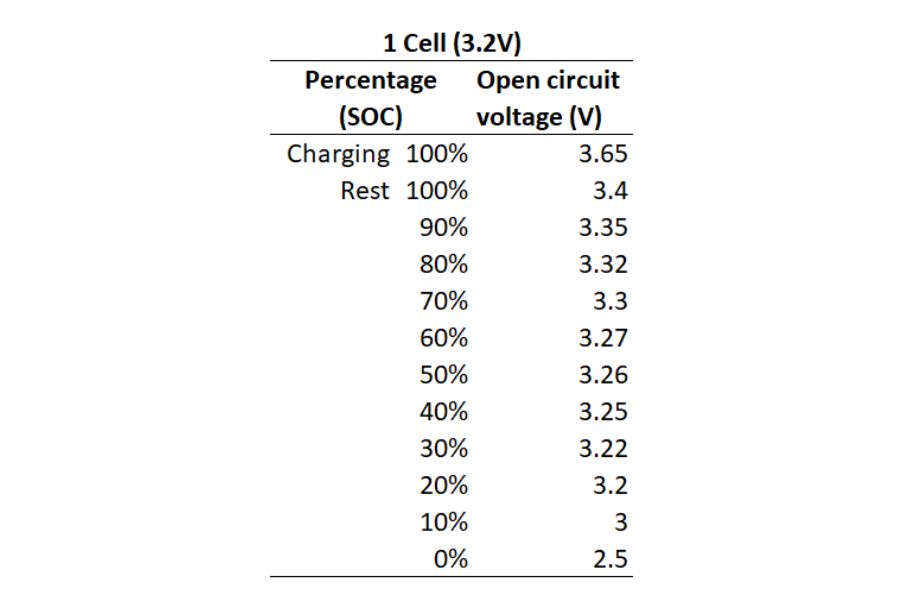
A better way to visualize the values in the chart above is using a simple line plot:
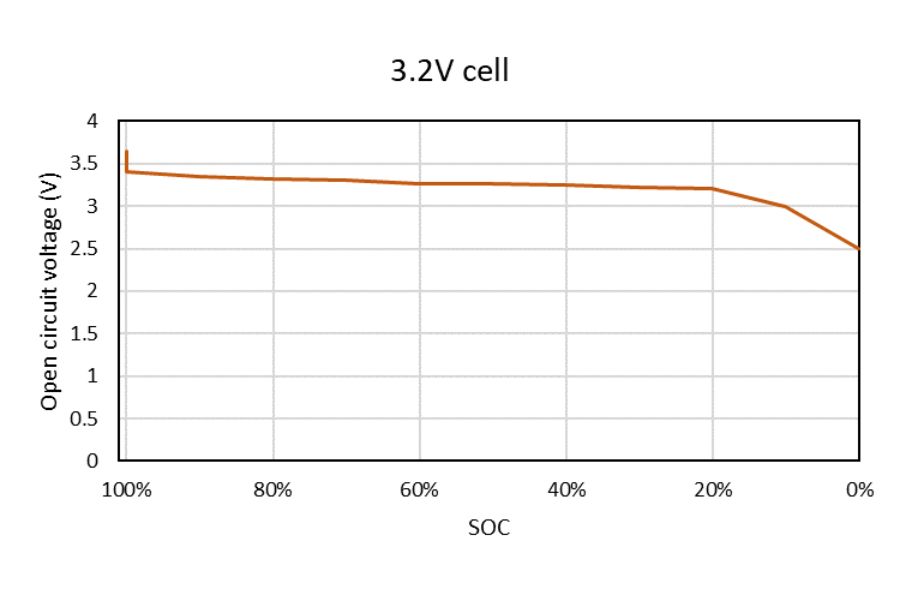
Key notes on 3.2V LiFePO4 cells:
- The maximum charge voltage is 3.65V. Minimum discharge is 2.5V.
- There is a negligible voltage drop from 100% to 20% SOC.
- Individual cells are often grouped together to form higher-voltage batteries.
12V LiFePO4 Battery Voltage Chart
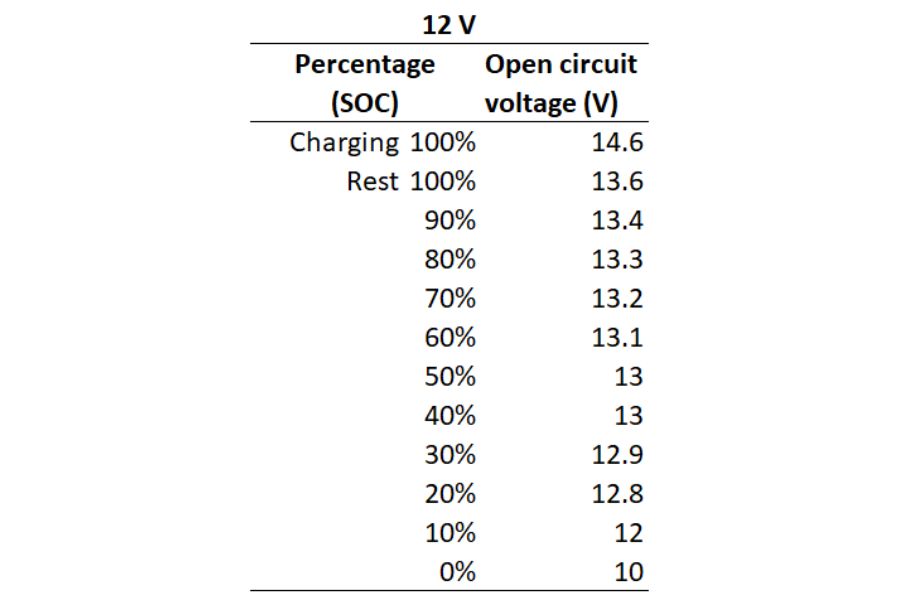
The voltage chart for a 12V LiFePO4 battery is plotted below:
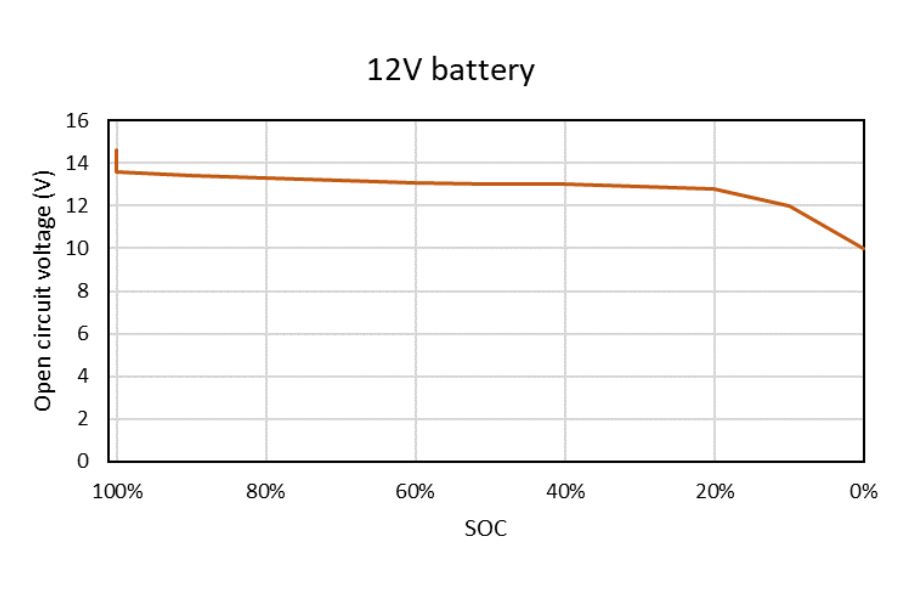
Key things to note:
- The fully charged voltage is 14.6V, and 10V is the low voltage cut-off.
- There is only a 0.8V drop from 100% to 20% state of charge.
- The “knee” of the curve is around 10-20% state of charge. Voltage falls rapidly in this zone.
- 12V LiFePO4 batteries are very popular for small to medium-sized off-grid solar energy systems.
24V LiFePO4 Battery Voltage Chart
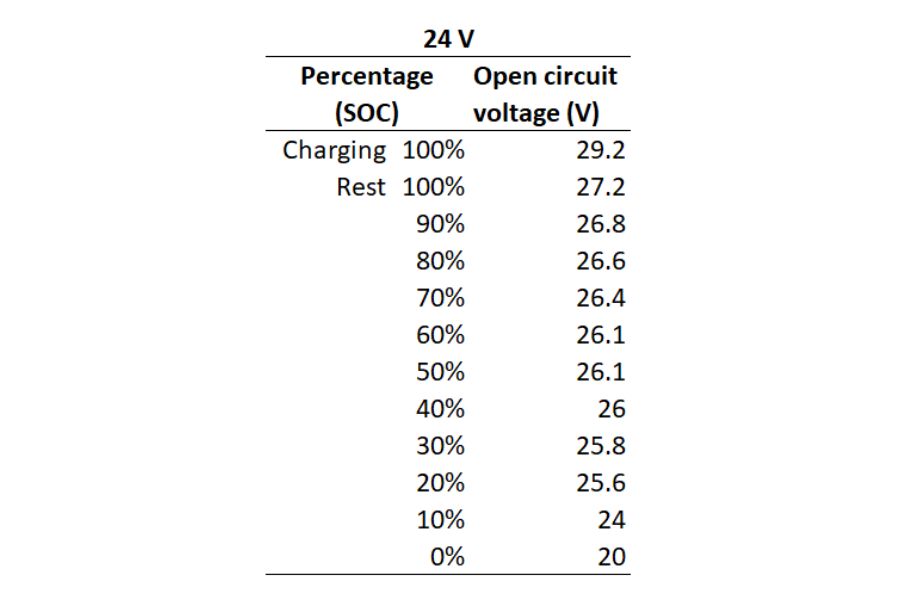
The line plot of the SOC vs. open circuit voltage for 24V LiFePO4 batteries is shown below:
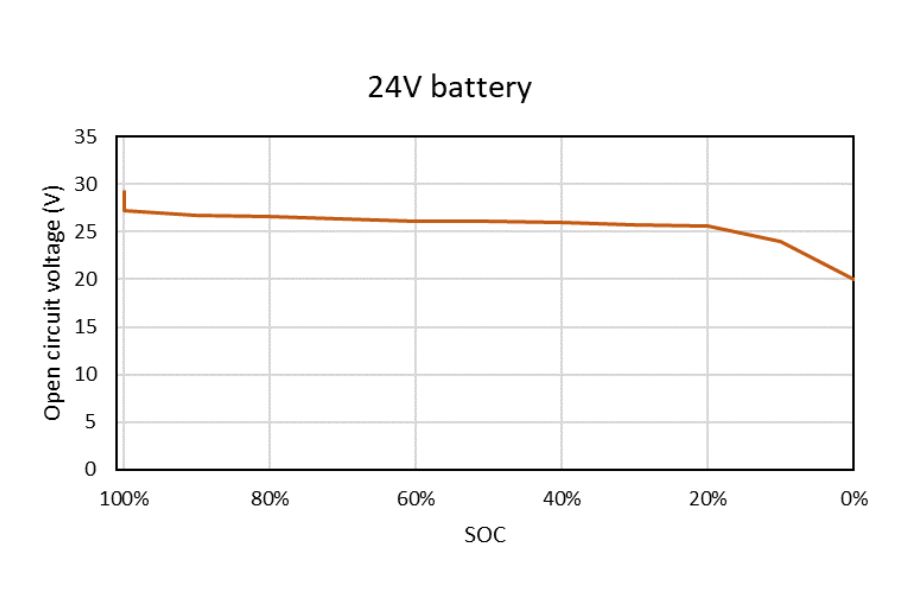
From the figure, it’s clear that:
- The fully charged voltage is 29.2V, and 20V is the typical low voltage cut-off.
- The flat voltage zone is from 80% to 20% state of charge.
- 24V batteries are a convenient option for doubling capacity over 12V systems.
48V LiFePO4 Battery Voltage Chart
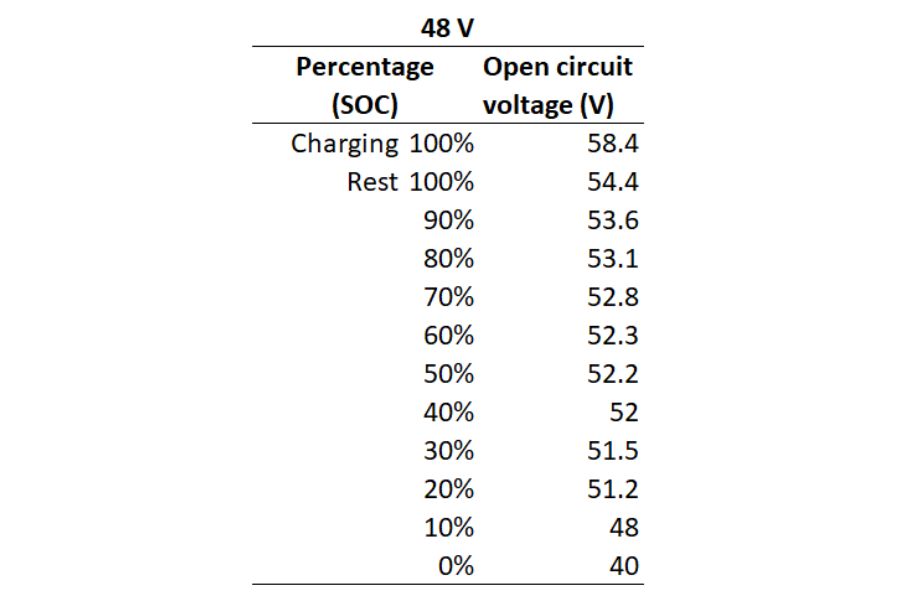
For 48V LiFePO4 batteries, the voltage chart is plotted below:
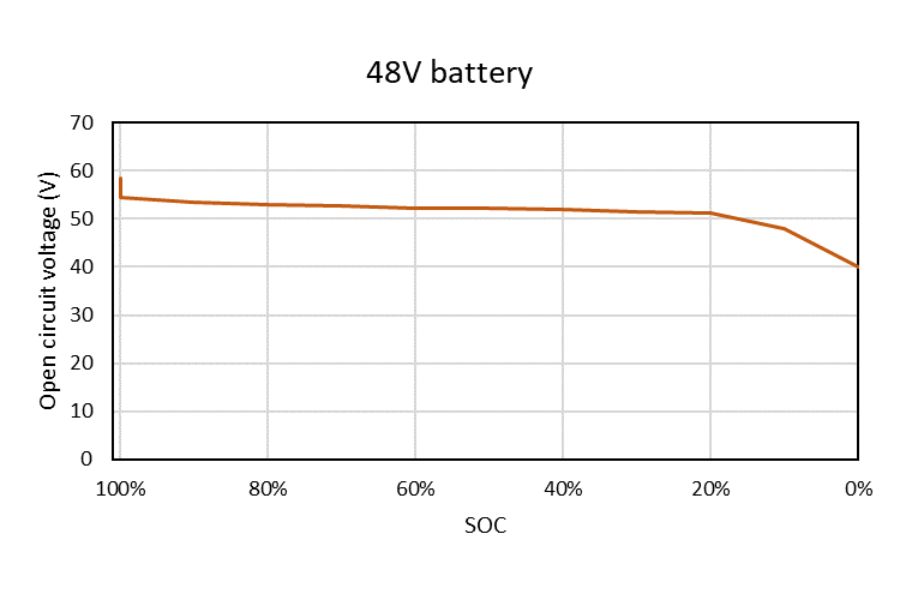
As shown in the chart:
- The fully charged voltage is 58.4V, and 40V is the typical low voltage cut-off.
- The voltage is most stable between 80% and 40% state of charge.
- 48V systems are suitable when higher power and lower current are desired.
Understanding LiFePO4 Batteries
Lithium iron phosphate, or LiFePO4, is a rechargeable lithium battery. Its distinguishing feature is lithium iron phosphate as the cathode material. Some other key features include:
- High Energy Density – LiFePO4 batteries can store much energy in a small, lightweight package. They have energy densities of up to 160 Wh/kg.
- Long Cycle Life – These batteries can withstand over 2000 cycles and maintain 80% of their original capacity.
- Improved Safety – LiFePO4 batteries are much more thermally and chemically stable than other lithium batteries. They are less prone to overheating and fire risks.
- High Power Capability – LiFePO4 batteries can deliver high discharge currents, making them suitable for powering motors and other high-draw devices.
- Low Self-Discharge – These batteries can hold their charge for long periods without losing much capacity.
- Cost-Effective – Although more expensive than lead-acid, LiFePO4 batteries offer much better performance per dollar over their lifetime.
Compared to lead-acid batteries, LiFePO4 batteries are lighter, more efficient, and have a longer lifespan. This makes them well-suited for solar energy storage and other renewable energy applications.
How Does a LiFePO4 Battery Work?
A LiFePO4 cell has a nominal voltage of 3.2V. By connecting cells in series, we can build batteries of different voltages:
- 12V battery = 4 cells in series
- 24V battery = 8 cells in series
- 48V battery = 16 cells in series
Lithium ions flow from the anode to the cathode when the battery is being used. This process generates electricity in the connected circuit. When charging, the ions flow reverse from the cathode to the anode.
LiFePO4 can discharge down to 90-100% of its rated capacity, unlike lead acid batteries, which should only be discharged to 50% to prevent damage.
How Battery Voltage and Capacity Are Related
LiFePO4 batteries exhibit a flat discharge curve. For most of the battery’s capacity, the voltage stays relatively constant. It is only at the extreme ends of the state of charge that the voltage changes drastically.
This differs from lead acid batteries, where the voltage curve slopes steadily downward as the battery discharges.
The flat voltage plateau makes it more challenging to estimate a LiFePO4 battery’s state of charge from voltage alone. However, the basic principle remains – higher voltage indicates more capacity, and lower voltage indicates less.
There are two main reasons the LiFePO4 voltage is so stable across most of the capacity range:
Low Internal Resistance
LiFePO4 batteries have very low internal resistance compared to lead acid batteries. This resistance opposes current flow and causes the terminal voltage to drop under load.
With less internal resistance, LiFePO4 battery voltage is less affected as the battery discharges. The result is a flatter discharge curve.
High Working Voltage
LiFePO4 cells have a nominal voltage of 3.2V, much higher than the 2V for lead acid batteries. This higher stack voltage means less relative change as the battery discharges.
For example, a 12V LiFePO4 battery may go from 14.4V fully charged to 12.8V near empty, a change of 12%. A 12V lead acid battery goes from 12.6V to 10.5V, a change of 20%.
While voltage and capacity have a direct relationship in LiFePO4 batteries, estimating the state of charge precisely from voltage alone can be difficult.
Advanced battery monitoring systems use current integration over time (coulomb counting) to track available capacity more accurately.
How a LiFePO4 Battery’s Voltage Affects Performance
A LiFePO4 battery’s voltage affects several aspects of its performance:
- Capacity – Higher voltage lets the battery store more energy in a given space. Capacity is proportional to voltage.
- Power – Voltage and current determine how much power a battery can deliver. Higher voltage enables more power output.
- Charging – The battery requires a minimum voltage threshold to charge properly. Low voltages may not fully charge the battery. High voltages can overcharge and damage it.
- Discharging – When the battery voltage drops too low, it can become damaged. The low voltage cut-off protects LiFePO4 cells from over-discharge.
- Lifespan – Repeatedly discharging to very low voltages and charging to very high voltages degrades the battery over time. Keeping voltages within an optimal range prolongs battery life.
- Safety – Excessive voltages increase the risk of overheating and other hazards. Proper voltage regulation is critical to safe operation.
So, the battery’s voltage affects capacity, power delivery, charging ability, lifespan, and safety. Monitoring voltage is essential to optimize the battery’s performance.
How to Read a LiFePO4 Battery Voltage Chart
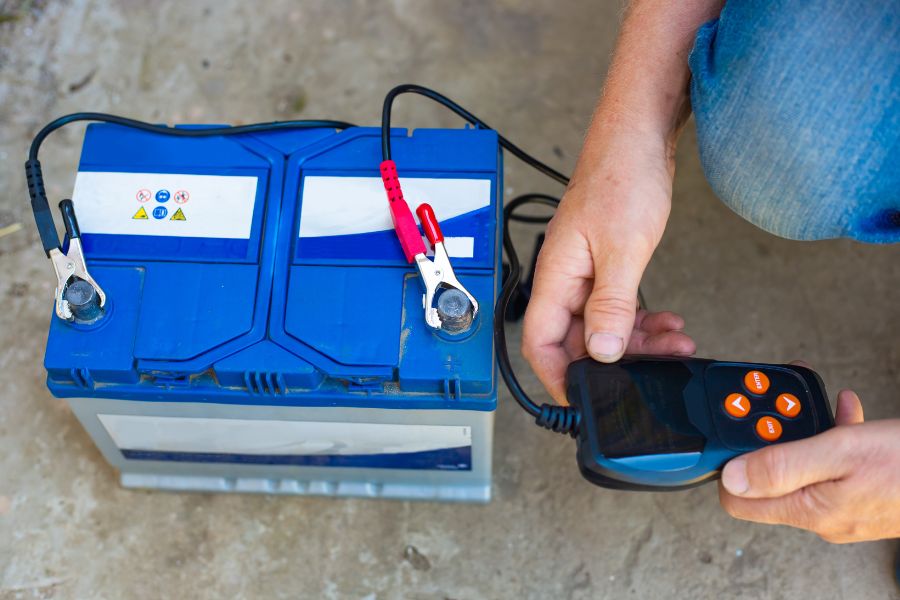
Let’s go through an example of using a LiFePO4 voltage chart to estimate the battery’s state of charge.
For this example, let’s say you have a 12V 200Ah (2400 Wh) LiFePO4 battery bank for an off-grid solar system. You want to check the remaining capacity before depleting the batteries too much.
Follow these steps:
- Make sure there are no loads or charging connected to the batteries. The voltage measurement must be taken at rest with no current flow.
- Use a multimeter to measure the voltage at the battery terminals. In our example, let’s say you measure 12.95V.
- Consult the voltage chart for a 12V LiFePO4 battery. Locate the row with 12.9V.
- The corresponding state of charge for 12.9V is 20%.
- So with the 200Ah battery bank, 20% of 200Ah is 40Ah. This is the estimated remaining capacity.
- You can make informed decisions about your power usage based on this available capacity. For example, limiting large loads until solar charging resumes.
This method roughly estimates the battery state of charge using a simple voltage measurement. For more precision, advanced battery monitoring systems also track current flow in and out of the batteries.
Factors Affecting Voltage Measurements
There are some important caveats when using voltage measurements to determine the state of charge:
- The battery must rest, with no charging or discharging currents. Loads of charging will alter the voltage.
- Temperature affects voltage. Measurements are most accurate at room temperature.
- Age and wear reduce battery capacity, so voltage may not correspond perfectly to a new battery.
- Discharge currents change voltage. Heavy loads make it drop more than light loads.
- Voltage recovers slightly when the load is removed before stabilizing. Measure after a rest period.
So, while voltage gives a good ballpark estimate, it does not indicate the state of charge with precision. Trends are more useful than absolute numbers.
Charging Voltage Requirements for LiFePO4 Batteries
Charging a LiFePO4 battery involves applying an external voltage to force the current to flow in reverse of its normal discharging direction. This replenishes the battery’s capacity.
The charging process proceeds through the following stages:
- Bulk Charging – The first charging stage. The charger applies an increasing voltage to deliver maximum current to the battery. This rapidly replenishes the charge.
- Absorption – After the bulk stage, the charger voltage is held constant at a slightly lower level as the current gradually tapers. This saturates the battery.
- Float – The float stage maintains the battery at full charge for lead acid batteries. However, LiFePO4 batteries do not require float charging.
- Equalization – Occasional overcharge to balance cell voltages. Rarely needed for LiFePO4 chemistry.
Moving through these stages brings the battery voltage from depleted back up to fully charged. Next, let’s look at the ideal charging voltage thresholds. There are a few key LiFePO4 voltage thresholds to consider:
- Bulk/Absorption Voltage – The maximum voltage applied to charge the battery up to 100% SOC. Usually 14.2V to 14.6V for 12V, 28.4V-29.2V for 24V, and 56.8V-58.4V for 48V batteries.
- Float Voltage – After a full charge, some chargers switch to a lower float voltage mode. Float is unnecessary for LiFePO4 batteries and should be disabled. If enabled, set no higher than 13.6V/27.2V/54.4V.
- Charging Current – How fast the battery is charged. 0.2C (20A for 100Ah battery) is ideal, 0.5C max. Higher currents generate heat, which degrades batteries over time.
- Low Voltage Disconnect – Disconnects the battery around 10-11.5V/20-23V/40-46V to prevent damage from over-discharge.
Frequently Asked Questions
How Can I Tell if My LIFEPO4 Battery Is Fully Charged?
A 12V LiFePO4 battery’s charging voltage of 14.4-14.6V indicates a full charge. A fully charged battery will settle to around 13.4-13.6V at rest with no loads.
Why Does My Voltage Reading Jump When the Load Turns Off?
This voltage recovery is normal. The current flow causes the voltage to dip under load. It bounces back up slightly once the current stops flowing. Let the voltage rest and stabilize before taking a measurement.
My Solar Charge Controller Shows Lower Voltage Than Directly at the Battery. Why?
Voltage drop along the wires and connections causes the controller’s reading to be lower than directly at the battery. Measure battery voltage right at the terminals for best accuracy.
How Can I Prolong the Lifespan of My LIFEPO4 Battery?
Avoid full discharges, charge to the recommended voltage levels, and prevent overheating and extreme high/low voltages.
Moderate cycling, shallow discharges, and proper voltage regulation give the longest battery life.
What Is the Difference Between Nominal Voltage and Charging/Discharging Voltage?
The nominal voltage is the rated battery voltage during normal operation.
Charging voltages are higher to charge the battery, while discharge voltages fall lower when driving a load.





